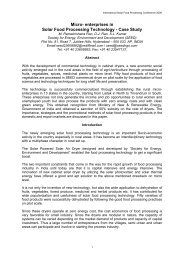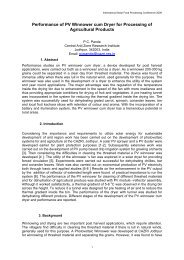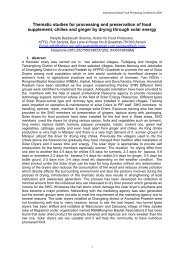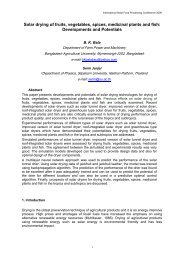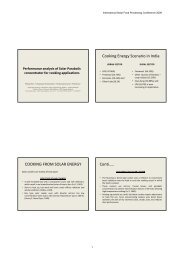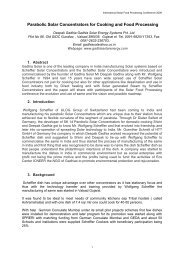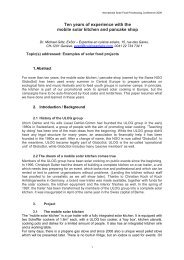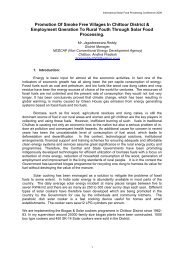Abstracts Oral Presentations - Solar Food Processing Network
Abstracts Oral Presentations - Solar Food Processing Network
Abstracts Oral Presentations - Solar Food Processing Network
Create successful ePaper yourself
Turn your PDF publications into a flip-book with our unique Google optimized e-Paper software.
International <strong>Solar</strong> <strong>Food</strong> <strong>Processing</strong> Conference 2009<br />
<strong>Solar</strong> drying of fruits, vegetables, spices, medicinal plants and fish:<br />
Developments and Potentials<br />
B. K. Bala, Department of Farm Power and Machinery<br />
Bangladesh Agricultural University, Mymensingh-2202, Bangladesh<br />
e-mail: bkbalabau@yahoo.com<br />
Serm Janjai, Department of Physics, Silpakorn University, Nakhon Pathom Thailand, e-mail:<br />
serm@su.ac.th<br />
• Topic(s) addressed: Local solar food processing technologies (oral presentation)<br />
1. Introduction<br />
Drying is the oldest preservation technique of agricultural products and it is an energy<br />
intensive process. High prices and shortages of fossil fuels have increased the emphasis on<br />
using alternative renewable energy resources. Drying of agricultural products using<br />
renewable energy such as solar energy is environmental friendly and has less environmental<br />
impact.<br />
Sun drying is still widely used in many tropical and subtropical countries. Sun drying is the<br />
cheapest method, but the quality of the dried products is far below the international<br />
standards. Improvement of product quality and reduction of losses can only be achieved by<br />
the introduction of suitable drying technologies. However, increase of purchasing power of<br />
the farmers of the dryers and the reflection of the quality in the price of quality dried products<br />
are the important prerequisites for acceptance by the farmers and introduction of improved<br />
drying technologies. As long as there is no or only slight difference in the price for high and<br />
low quality products, the additional expenses for new preservation techniques will never be<br />
paid back and the new drying technologies will not be acceptable by the farmers. However,<br />
for adoption of the improved technology field level demonstration of the technology and<br />
advertisement of the quality dried products are essential. Micro-credit may also be needed<br />
and an extension model which is also an extension of the micro-credit approach of Grameen<br />
Bank may be adopted. Furthermore, for sustainability of the improved drying technology<br />
marketing channels must be established.<br />
<strong>Solar</strong> drying can be considered as an elaboration of sun drying and is an efficient system of<br />
utilizing solar energy. The tropics and subtropics have abundant solar radiation. Natural<br />
convection solar dryers do not require power from the electrical grid or fossil fuels. Hence the<br />
obvious option for drying would be the natural convection solar dryers. Many studies on<br />
natural convection solar drying of agricultural products have been reported. Several designs<br />
are available and these are (i) cabinet type solar drier suitable for drying fruits and<br />
vegetables, (ii) indirect natural convection solar drier for paddy drying and mixed mode AIT<br />
drier for drying paddy. These dryers have been widely tested in the tropical and subtropical<br />
countries. Considerable studies on simulation and optimization have also been reported. The<br />
success achieved by indirect natural convection solar dryers has been limited, the drying<br />
rates achieved to date not having been very satisfactory. Box type dryer is suitable for drying<br />
of 10 – 15 kg of fruits and vegetables. The mixed mode dryer and AIT drier are improvement<br />
over the indirect natural convection solar dryer. All of these types of dryers have been tested<br />
and attempts have been made to extend at the farm levels. But none of these dryers<br />
practically exist in the fields in the tropics and subtropics. However, Kenya black box dryer<br />
which is a mixed mode solar dryer is claimed to be appropriate for small scale drying.<br />
Furthermore, these dryers are not suitable for small scale industrial production of fruits,<br />
vegetables, spices, fish and medicinal and herbal plants. These prompted researchers to<br />
develop forced convection solar dryers. These dryers are (i) solar tunnel drier, (ii) indirect<br />
forced convection solar drier, (iii) Greenhouse type solar drier, (iv) Roof integrated solar drier<br />
and (v) <strong>Solar</strong> assisted dryer. Numerous tests in the different regions of the tropics and<br />
subtropics have shown that fruits, vegetables, cereals, grain, legumes, oil seeds, spices, fish<br />
and even meat can be dried properly in the solar tunnel dryer.<br />
27





